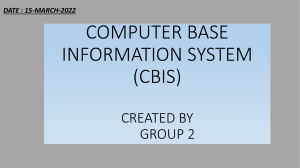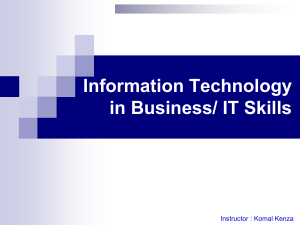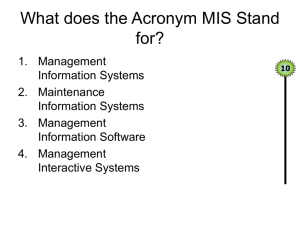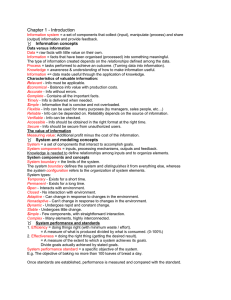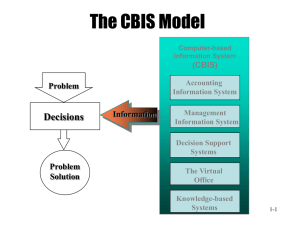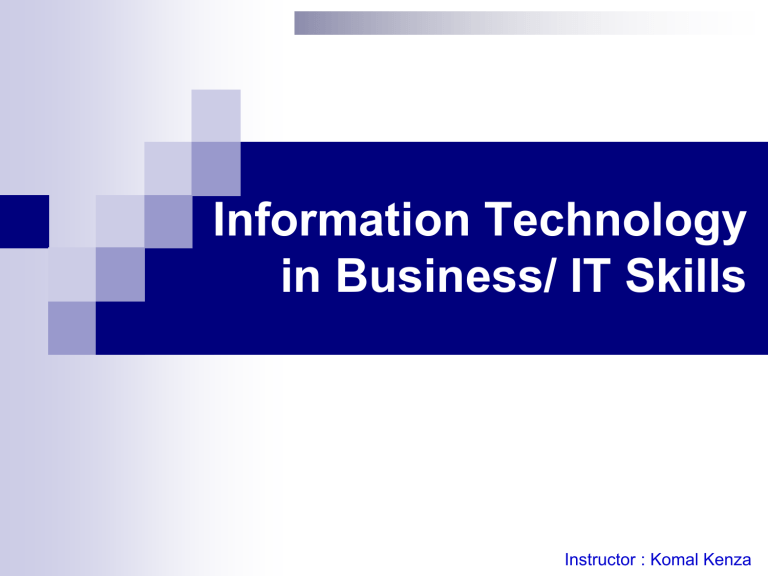
Information Technology in Business/ IT Skills Instructor : Komal Kenza Grading Policy Assessment Instruments Percentage Quizzes 15% Assignments + Project + Presentation 20% Mid Term Exam 25% Final Exam (Practical) 40% 2 Quiz /Assignment Policy Most of the Quizzes will be announced. Being absent means zero in the quiz with no option of retaking. Five quizzes will be taken and best four will be added in the total. Late submission of assignments will either not be entertained or will result in the deduction of marks. 3 Plagiarism/Cheating Policy Copying and Pasting from the internet without citing source is not allowed. Copying assignment of anyone and turning it in as yours own not allowed. Zero Tolerance 4 Text Book(s): O’Brien, J.A., Marakas, G.M., 2010. Introduction to Information Systems. McGraw-Hill Irwin.Gookin, D., 2011. Analysis and design of information system by James A Senn Information to Information Technology by Turban Rainer Potter, Using Information Technology: A practical introduction to computers & communications, by Williams Sawyer Hutchinson Introduction to Computer Information System for Business by Mark G. Sinkin. Information Technology for Business Executives by Dr. Amjad Saeed. 5 About the course Course overview This is introductory course on Information Technology in Business. Course outline includes IT terminologies, hardware, software components, internet and all IT based applications. 6 Information Technology Two Key Terms ? INFORMATION TECHNOLOGY ? The use of Tools/ Machines/ techniques to transform data into information is called IT “It is processed form of data which is meaningful to the “RECEIPIENT” for the current and progressive decision making” “The use of Tools/ Machines/ techniques to perform jobs with more ease 7 Technology As A Business Necessity The role of technology in business caused a tremendous growth in trade and commerce. Business concepts and models were revolutionized as a result of the introduction of technology. This is because technology gave a new and better approach on how to go about with business. It provided a faster, more convenient, and more efficient way of performing business transactions. 8 Role of IT in Business Communication Inventory Management. Data Management Management Information Systems Customer Relationship Management 9 What is a System? A set of interrelated components With a clearly defined boundary Working together To achieve a common set of objectives 10 What Is A System? Systems have three basic functions: 1. Input: Involves capturing and assembling elements that enter the system to be processed. Example: - raw materials, - energy, - data. What Is A System? (continued) Systems have three basic functions (continued): 2. Processing: involves transformation processes that convert input into output. Example: - manufacturing process, 3. Output: involves transferring elements that have been produced by a transformation process to their ultimate destination. Example: - finished products, - human services 12 What is an Information System? An organized combination of… People Hardware and software Communication networks Data resources Policies and procedures This system… Stores, retrieves, transforms, and disseminates information in an organization 13 General Information Systems Diagram Management Decisions Data Input Process Control Feedback Output Information Components of Computer based information system(CBIS (IT) Components of CBIS (IT) specialist (system analysts, software developers, system operators). end users (anyone else who uses Components of CBIS (IT) Electronic transmission of signals for communication Networks: Internet: Intranet: Extranet: Components of CBIS (IT) programs (operating system program, spreadsheet programs, word processing programs) Components of CBIS (IT) machines (computers, video monitor, magnetic disk drives, printers, optical scanners). media (floppy disks, magnetic tape, optical disks, plastic cards, paper forms). Components of CBIS (IT) - product description, customer records, employee files, inventory databases Components of CBIS (IT) Set of rules or instructions about how to combine information system components in order to process information and generate desired output. Fundamental Roles of IS in Business 22 The Fundamental Roles Of Information System In Business There are three fundamental reasons: 1. Support of its business processes and operations. 2. Support of decision making by its employees and managers. 3. Support of its strategies for competitive advantage. Types of Business information system 24 Types of Business Information Systems 25 Types Of Business Information Systems Information Systems Operations Support Systems Management Support Systems 26 Types Of Business Information Systems Operations Support Systems Specialized Processing Systems Transaction Processing Systems Process Control Systems Enterprise Collaboration Systems 27 Types Of Business Information Systems Management Support Systems Management Information Systems Decision Support Systems Executive Information Systems Specialized Processing Systems 28 Types Of Information Systems (continued) Operations support systems: 29 Types Of Business Information Systems Operations support systems (continued): - Process control systems. -- monitor and control industrial process. Examples: Petroleum refining, power generation,steel producing systems, using sensors to monitor chemical processes in a petroleum refinery Types Of Business Information Systems Operations support systems (continued): - Enterprise collaboration systems. -- support team, workgroup, and enterprise communications and collaboration. Examples: email, chat, video conferencing groupware systems. Types Of Business Information Systems Management support systems: - Management information systems -- provide information in the form of pre specified reports and displays to support business decision making. Examples: Sales analysis, production performance, cost trend reporting systems. Types Of Business Information Systems Management support systems (continued): - Decision support systems -- provide interactive ad hoc support for the decision making processes of managers and other business professionals. Examples: product pricing, profitability forecasting, risk analysis. Other Business Information Systems Expert Systems - provide expert advice Example: credit application advisor Knowledge Management Systems - support creation, organization, and distribution of business knowledge throughout company Example: intranet access to best business practices Strategic Information Systems - help get a strategic advantage over customer Example: shipment tracking, e-commerce Web systems Functional Business Systems - focus on operational and managerial applications of basic business functions Example: accounting, finance, or marketing 34 Business Examples INFORMATION SYSTEM ACTIVITIES Input. (optical scanning of bar coded tags on merchandise) Processing. (calculating employee pay, taxes, and other payroll deductions) Output. (producing reports and displays about sales performance) Storage. (maintaining records on customers, employees, and products) Control. (generating audible signals) 35
